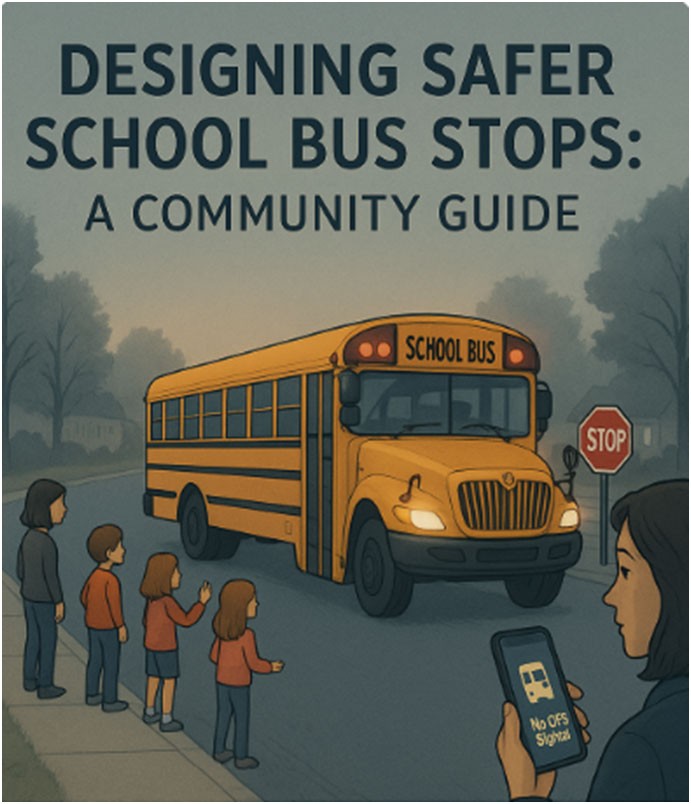
Designing Safer School Bus Stops: A Community Guide
Ensuring the safety of children at school bus stops is a critical concern for every community. With increasing traffic and digital distractions, this guide provides actionable steps for school districts, local governments, and parents to collaborate and create safer environments using modern technology and proven best practices.
Contents
- Introduction
- Understanding the School Bus Stop Safety Challenge
- Safety Audit & Assessment Checklist
- Designing Safer Bus Stops
- Integrating Technology for Enhanced Safety
- Community Involvement & Case Studies
- Implementing and Monitoring Changes
- Conclusion & Call to Action
Introduction
Every school day, over 25 million students across the U.S. depend on school buses, making bus stops critical safety zones. Yet, statistics from the National Highway Traffic Safety Administration (NHTSA) show that 71% of school bus-related fatalities occur outside the bus. This sobering fact highlights the urgent need for communities to focus on bus stop safety as part of their overall student transportation strategy.
This comprehensive guide fills an important gap by providing school districts, local governments, and parents with clear, data-driven strategies to assess, design, and improve bus stop safety. By approaching this challenge systematically, communities can significantly reduce risks and create environments where students can safely begin and end their school day journeys.
By leveraging innovative tools like Wayfinder GPS and School Bus Stop Locators, communities can not only address current safety challenges but also establish ongoing improvement programs that are both effective and engaging. This technology-enhanced approach helps bridge the gap between traditional safety measures and the demands of our increasingly complex traffic environments.
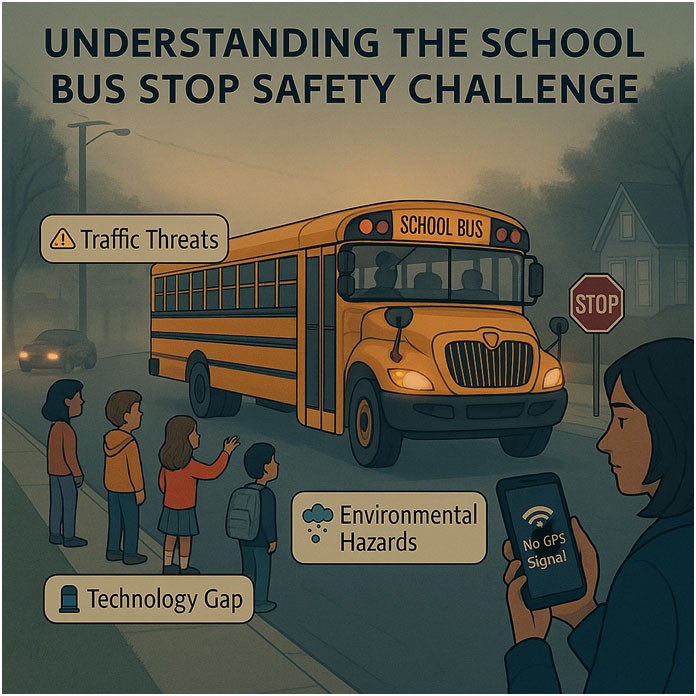
School bus stops are complex intersections of safety considerations. They often operate during peak traffic hours and in areas with unpredictable environmental conditions. Recognizing the specific risks associated with these locations is the first step to crafting effective solutions that address both immediate hazards and systemic challenges.
Key Risk Factors
- Traffic Threats: High-speed roads, impatient drivers, and insufficient crossing guards significantly increase the risk of accidents. A CDC study found that 45% of bus stop accidents involve drivers illegally passing stopped buses, highlighting the need for both enforcement and design solutions.
- Environmental Hazards: Poor lighting, adverse weather conditions, and obstructed sightlines (per NHTSA guidelines) are common hazards that compromise student safety. These factors are particularly concerning during early morning hours when many students are waiting for buses in limited visibility conditions.
- Technology Gaps: Only 38% of school districts currently use real-time GPS tracking for buses, leaving many parents unaware of delays or dangerous conditions. This information gap can lead to extended waiting times at stops, increasing exposure to potential hazards.
Understanding these core challenges helps stakeholders appreciate the need for a comprehensive safety strategy that integrates both traditional design principles and modern technology solutions like Safe School Bus Routes. When communities recognize the multifaceted nature of bus stop safety, they can develop more effective and sustainable solutions.
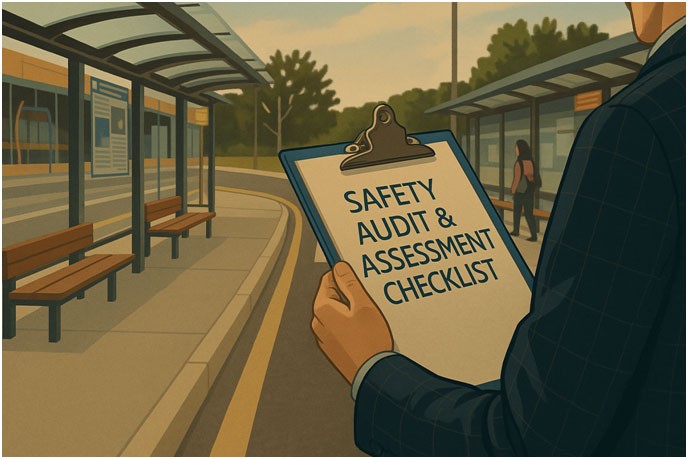
Safety Audit & Assessment Checklist
Before making any changes, it is essential to conduct a thorough safety audit of existing bus stops. A systematic assessment helps identify immediate hazards and prioritize improvements based on risk level, budget constraints, and implementation feasibility. This data-driven approach ensures that resources are allocated where they will have the greatest impact on student safety.
Steps to Assess Bus Stop Safety
- Conduct a Walkthrough: Physically inspect each bus stop for potential hazards such as obstructed views or inadequate waiting spaces. Document findings with photographs and detailed notes for later reference and planning.
- Gather Data: Use GPS technology (e.g., School Bus Stop Locators) to map current stops and analyze traffic patterns. This technology can reveal patterns and risk factors that might not be apparent during individual site visits.
- Collect Community Feedback: Engage parents, bus drivers, and local residents to identify safety concerns from firsthand experience. Their observations often highlight practical issues that technical assessments might miss.
Safety Audit Checklist for Bus Stops
- Visibility from all approaching directions (minimum 500 feet recommended)
- Adequate waiting space away from the roadway (minimum 6 feet from edge)
- Presence of sidewalks or safe pedestrian pathways
- Traffic speed and volume during bus stop times
- Effective lighting conditions, especially during early morning or evening hours
- Proximity to intersections, driveways, or high-traffic areas
- Environmental factors (drainage, vegetation, snow removal access)
- Accessibility features for students with disabilities
- Clear signage and road markings alerting drivers to the presence of a bus stop
This detailed checklist provides communities with clear criteria to evaluate current conditions and identify areas that require urgent attention. By documenting these assessments systematically, school districts can build a comprehensive database of bus stop conditions that informs both immediate improvements and long-term planning.
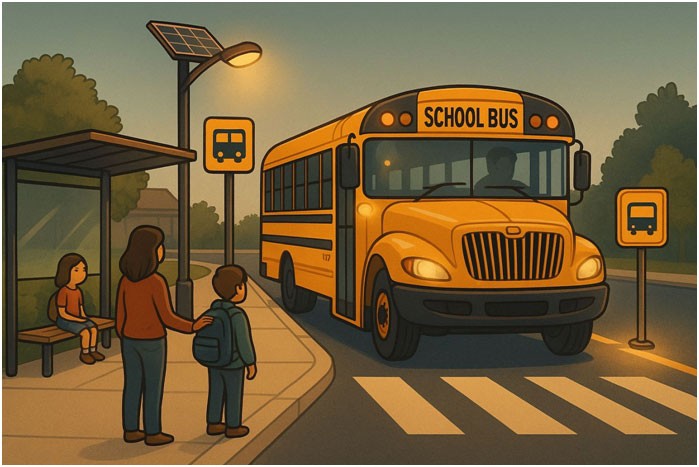
Designing Safer Bus Stops
Effective design not only enhances physical safety but also improves the overall user experience for students, parents, and bus drivers. A well-designed bus stop considers both structural improvements and the integration of technology, creating a comprehensive safety solution that addresses multiple risk factors simultaneously.
Key Design Elements
- Location and Visibility: Ensure bus stops are located in low-traffic areas with clear sightlines. Avoid blind spots created by buildings, trees, or curves in the road. When possible, position stops at least 100 feet from intersections to prevent conflicts with turning vehicles.
- Infrastructure Improvements: Incorporate safe waiting areas, clear signage, and proper lighting. Consider solutions like solar-powered lights and raised platforms in high-risk zones. These physical enhancements create clear boundaries between waiting areas and traffic, reducing the risk of accidents.
- Safe School Bus Routes: Use School Bus Stop Locator technology to design routes that maximize safety by steering clear of dangerous intersections or high-speed roads. This route optimization should balance safety considerations with reasonable walking distances for students.
By following these guidelines, communities can create bus stops that not only protect students but also enhance the overall commuting experience. Well-designed bus stops also send a clear message to motorists about the presence of children, encouraging greater caution in these areas even when buses are not present.
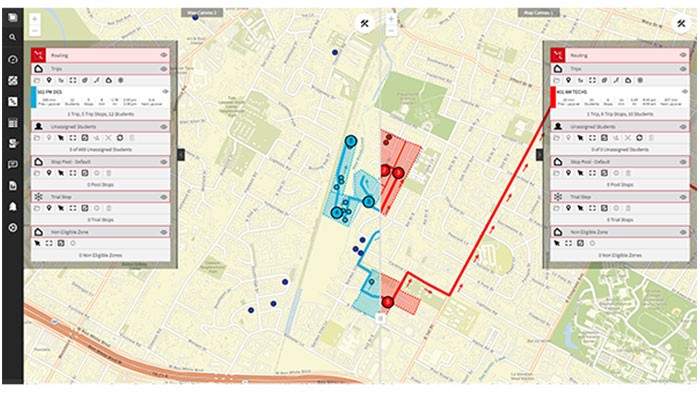
Integrating Technology for Enhanced Safety
Modern technology plays a crucial role in transforming school bus stop safety. Digital tools provide real-time data and streamline communication between stakeholders, creating a more responsive and adaptive safety system. These technological solutions complement physical design improvements, addressing aspects of bus stop safety that cannot be solved through infrastructure alone.
Technology Solutions to Consider
- Wayfinder GPS: Provides detailed mapping and real-time tracking of bus locations, allowing parents and school administrators to monitor routes and schedules. This visibility reduces uncertainty and helps families plan their morning routines more effectively.
- GPS Tracking Systems: Alert parents when buses are approaching, reducing wait times and potential roadside hazards. These notifications can be particularly valuable during adverse weather conditions or when buses are running behind schedule.
- Routing Software: Optimizes bus routes by analyzing traffic patterns and environmental factors to create safer, more efficient routes. Advanced algorithms can factor in multiple safety parameters to identify the optimal placement of bus stops.
- Mobile Applications & QR Codes: Offer real-time updates and easy access to safety information, enhancing community engagement and responsiveness. These tools put critical information directly in the hands of parents and students, empowering them to make safer decisions.
Integrating these tools can significantly improve operational efficiency and safety, as demonstrated by successful case studies in several school districts. The data generated by these systems also provides valuable insights for ongoing assessment and improvement of bus stop safety measures.
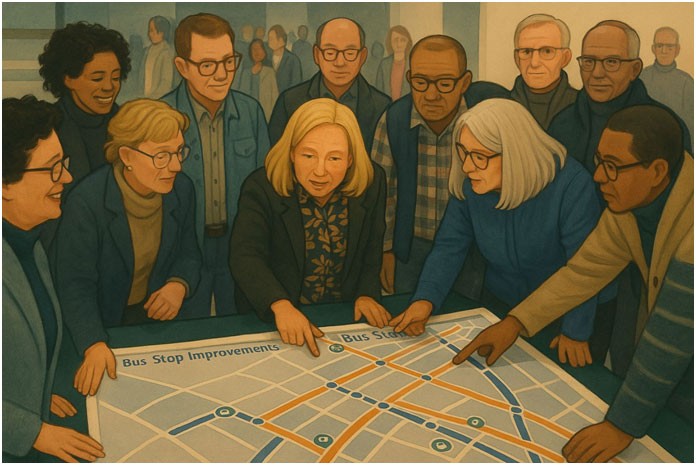
Community Involvement & Case Studies
Creating a safe school bus stop environment is a shared responsibility that extends beyond the transportation department. Effective collaboration among school districts, local governments, parents, and community safety groups is essential for developing solutions that address the specific needs and challenges of each community.
Engaging Key Stakeholders
- School Districts & PTAs: Lead safety initiatives and work with transportation departments to implement improvements. Their institutional knowledge and access to resources make them natural coordinators for comprehensive safety programs.
- Local Governments: Invest in infrastructure and enforce traffic regulations that support safe bus stops. Their authority over public roadways and traffic control is essential for implementing many physical improvements.
- Parents and Students: Provide feedback and participate in safety audits to ensure practical, on-the-ground insights. Their daily experience with bus stops offers valuable perspective that professional assessments might miss.
Real-World Case Studies
Several communities have successfully improved bus stop safety through collaborative efforts. For example:
- Montgomery County, MD: A coordinated approach among the school district, local transportation, and parent volunteers led to a complete redesign of high-risk bus stops. Their program included a comprehensive audit of all stops, prioritization based on risk factors, and phased implementation of improvements.
- Westfield School District, IA: Implemented solar-powered LED lighting at rural bus stops, coupled with a School Bus Stop Locator app, significantly improving safety without major infrastructure investments. This solution was particularly effective for addressing visibility issues during early morning hours.
- Fairfax County Public Schools, VA: Integrated a comprehensive school transportation technology platform, combining real-time tracking and route optimization to provide parents with accurate bus arrival times and reduce waiting periods. Their system reduced average waiting times by 37%, significantly decreasing student exposure to roadside hazards.
These case studies serve as practical models that communities can adapt to their local needs. By learning from successful implementations elsewhere, school districts can avoid common pitfalls and accelerate their own safety improvements.
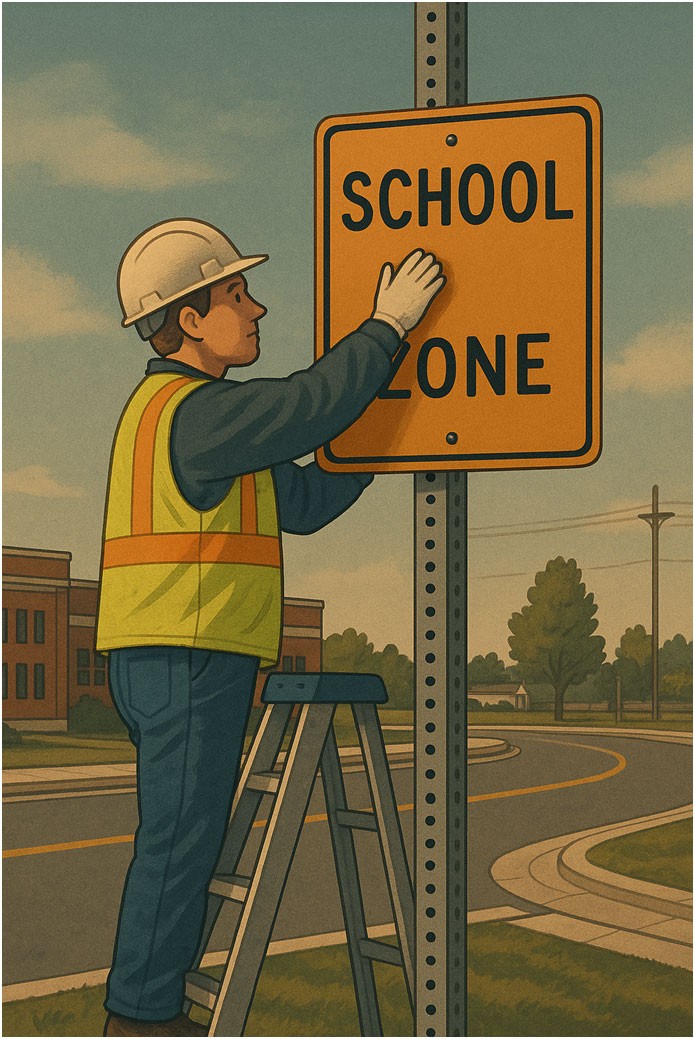
Implementing and Monitoring Changes
Effective implementation requires a clear, phased plan and continuous monitoring to ensure that safety measures remain effective over time. This structured approach helps maintain momentum and ensures that resources are used efficiently throughout the improvement process.
Steps for Implementation
- Develop a Detailed Plan: Outline the necessary improvements, assign responsibilities, and establish timelines. This plan should include both short-term fixes for high-risk areas and longer-term systemic improvements.
- Secure Funding: Collaborate with school districts and local governments to allocate the budget needed for infrastructure upgrades and technology integration. Consider grants, community partnerships, and phased implementation to manage costs effectively.
- Execute Changes: Implement safety improvements in phases, ensuring clear communication with all stakeholders. Begin with high-priority locations while planning for broader systemic changes.
- Monitor Performance: Use digital analytics (such as real-time tracking and user feedback) to assess the impact of changes and make data-driven adjustments. Establish key performance indicators (KPIs) to measure success and guide ongoing improvements.
This structured approach ensures transparency, accountability, and continuous improvement in school bus stop safety initiatives. By treating safety improvement as an ongoing process rather than a one-time project, communities can adapt to changing conditions and incorporate new best practices as they emerge.
Conclusion & Call to Action
Designing safer school bus stops is a multifaceted challenge that requires a coordinated effort, innovative design, and ongoing community engagement. By assessing current conditions, adopting best practices, and leveraging modern technology like Wayfinder GPS, communities can significantly enhance student safety and create a culture of vigilance and improvement.
The strategies outlined in this guide provide a framework for action that can be adapted to the specific needs and resources of any community. Whether implementing comprehensive technology solutions or making targeted infrastructure improvements, every step toward safer bus stops represents an investment in student wellbeing and community peace of mind.
We encourage school districts, local government officials, and parents to use this guide as a blueprint for change. Share this resource with your local school board, PTA, or community safety group, and take action today to ensure that every child's journey to and from school is as safe as possible.
For more information on innovative school transportation solutions and digital safety tools like Wayfinder GPS and School Bus Stop Locators, please visit the Transfinder website.
References
- National Highway Traffic Safety Administration (NHTSA). (2023). Pedestrian Safety Around School Buses.
- U.S. Department of Transportation. (2023). Guidelines for Safe School Bus Routes.
- Centers for Disease Control and Prevention (CDC). (2023). Traffic Safety and Bus Stop Accidents.
- Transfinder. (2023). Innovative School Transportation Solutions.
© 2025 Transfinder.com. All rights reserved.



